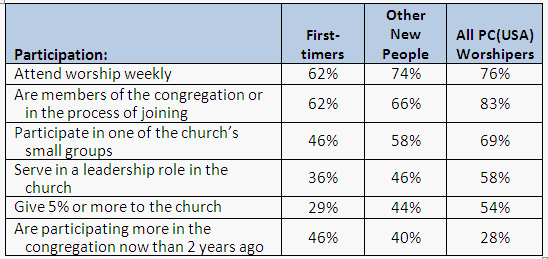Deborah Bruce and Joelle Anderson recently co-authored an article exploring research about the makeup of new church members. More specifically, they considered who is joining Presbyterian (PCUSA) congregations. They report that “in the typical PC(USA) congregation about three in ten worshipers are new people who began attending there in the past five years.” These newcomers can be grouped into four categories:
- First-timers with no church background. Only 8% of new people in Presbyterian churches are first-timers.
- Returnees who had not been attending anywhere before starting at their current congregation, but had attended worship somewhere at some time in the past. One-quarter of new people (23%) are returnees.
- Switchers who changed denominations or faith groups when they began attending their current congregation. Four in ten new people (40%) are switchers.
- Transfers who had attended another Presbyterian congregation before starting at their current congregation. Three in ten new people (30%) are transfers.
So What?
While newcomers come from a variety of sources, they are less active in congregational activities and worship. This is especially true of the first-timers, which is illustrated in the chart below:
Questions for congregations:
- Do you track where your newcomers come from? If so, how similar are the percentages to the averages in the PC(USA) study?
- Is there something about your congregational DNA that is likely to attract a disproportionate percentage of newcomers from a specific category? If so, what is it and how do you capitalize on this in your current marketing efforts?
- While getting people to become a part of your congregation is important, it is essential that these newcomers are assimilated so that they deepen their involvement and do not walk out the back door for good. Explain your current assimilation ministry and note what you see as its greatest strengths and weaknesses.
